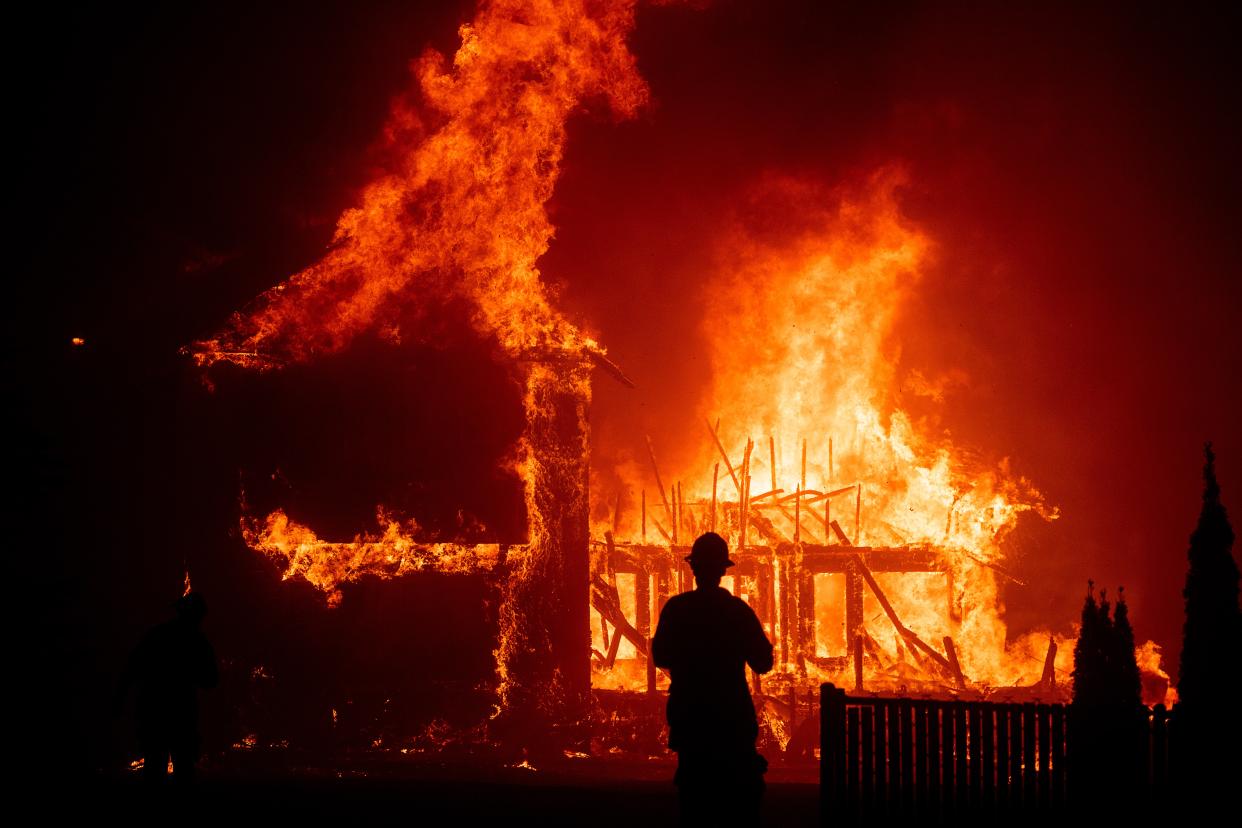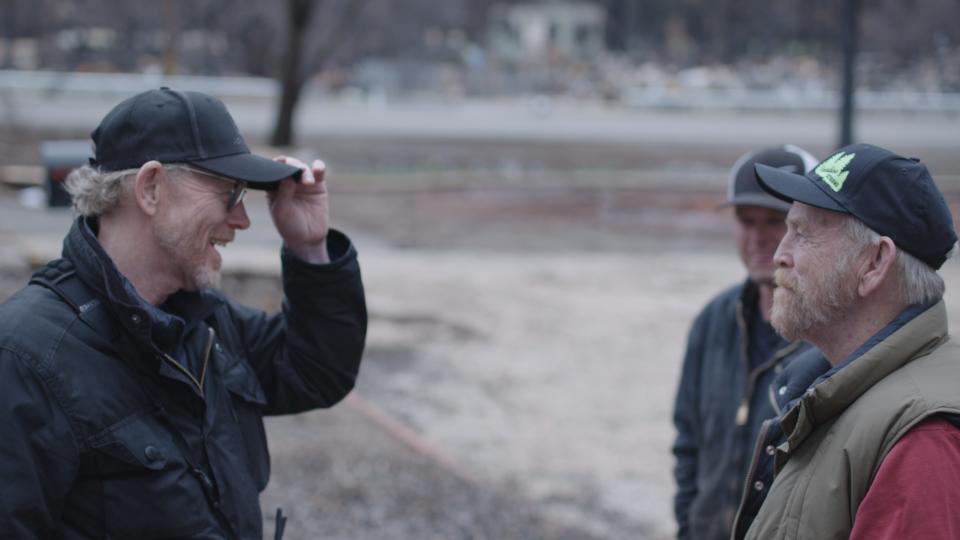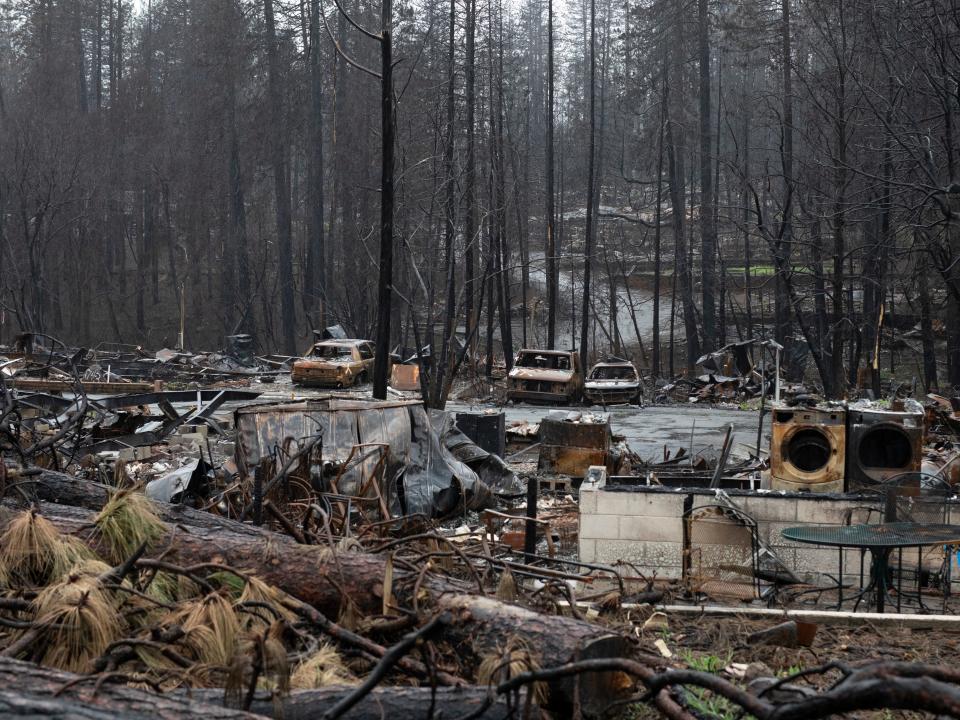‘Everybody at some point was certain they were going to die’: Paradise’s former mayor recalls devastating wildfire two years on

Early on 8 November 2018, Steve "Woody" Culleton was driving to work 20 miles away from his home in Paradise, California, when he spotted a cloud of smoke.
“I happen to have a police scanner, so I turned it on. By 7.12am, fire was in Paradise behind the hospital. The winds were blowing 40-50 miles an hour,” he told The Independent.
Mr Culleton, now 76, raced home to find that “fire was already in the neighbour’s yard”.
Within minutes thousands of residents in Paradise, a town in the Sierra Nevada foothills which dates to California’s Gold Rush, were trying to escape an out-of-control wildfire. By 8am, all lanes of the town’s three main roads were flowing out of town and the cross streets were jammed with traffic.
“I met my wife at the house and tried to grab our pets but we weren't able to corral them,” Mr Culleton recalled. “We grabbed a few things and got in separate vehicles. I went to pick up our adult daughter and my wife continued on, trying to get out of town.”
For five hours, the Culletons and thousands of others slowly crept through smoke and flames, watching all around them being set alight.
“The whole town was catching on fire. It was everywhere, on both sides of the road,” Mr Culleton said. “At 9am, it was like midnight because the smoke was so black. Embers were blowing across [the road]. It was just frightening.”
The family lost their home and possessions in the devastating firestorm, named Camp Fire. By the time it was extinguished, 85 people had lost their lives, the deadliest blaze in a century in the US. Some 50,000 people were displaced and 95 per cent of structures in the 141-year-old town were destroyed.
With almost 6,000 first responders battling the fire, it was finally contained 17 days later. The damages ran to $16bn.
The story of how the fire impacted the small community, and the arduous recovery that followed, is the subject of Rebuilding Paradise, a National Geographic documentary from Ron Howard, the Oscar-winning director of movies A Beautiful Mind and Apollo 13.
It premiered in the UK earlier this week and in the US on the two-year anniversary of the tragedy.
The documentary begins with heart-stopping footage contributed by Paradise residents of fleeing the fire. At one point on a shaky cameraphone, a family break down as they emerge from the smoke and daylight appears.
Mr Culleton identified with the sense of relief. “When we finally got to a place where sky was blue again, my daughter and I were safe,” he said.
Beyond the dramatic scenes, the documentary encapsulates the grim aftermath. Stunned public officials survey ashen remains of homes and schools while fire crews move body bags and search charred vehicles for remains.
Local cop Matt Gates loses his composure as he recalls hugging a woman on discovering she was alive after he had spent time searching for her body.
Howard’s film crew spent a year in Paradise following the grieving community as residents faced relocations, financial stress, bureaucratic red tape, water poisoning, and post-traumatic stress disorder.
“When we went to Paradise, the range of emotions was so palpable on people’s faces and in the words of the people I was meeting — some of whom we were rolling cameras on, and some of whom we were just speaking to in order to grasp it all,” the director said.
“I have never been around anything like that kind of devastation. It was jaw-dropping and heartbreaking.”

Mr Culleton was one of a number of local people to appear in the film, along with Officer Gates, who told of watching his home burn as he evacuated people. There’s also school superintendent Michelle John, whose husband Phil died while the film was being made, and Carly Ingersoll, a school psychologist who helped students cope with the trauma.
Mr Culleton, a bearded, ball-cap wearing, born-and-raised Californian from the Bay area, could pass for Ron Howard’s outdoorsy older brother. He described the director as a “salt-of-the-earth kind of person, not some Hollywood type, and a real craftsman at what he does”.
A military veteran, Mr Culleton matter-of-factly describes a two-decade struggle with alcohol and drugs and 10 years of homelessness before he found himself in Paradise in 1981, where he got sober, met his wife and put down roots.
“This is the place everything came together for me, and within a day it was gone,” he says in the film.
In 2012, Mr Culleton was chosen as town mayor during a 12-year stint on the city council.
“I went from being the town drunk to the town mayor,” he quips. (He was re-elected to the council earlier this month for another four years.)
Mr Culleton was among the first people to return to Paradise following Camp Fire. He said that he felt the government let people down in the immediate aftermath.
“[The government] wouldn't let people in, wouldn't tell anyone anything. We spent two or three days driving around, filming, calling people to say, ‘Hey your house is here, your house is gone.’ Driving vehicles out ... We just did things that the government failed to do.”

As the months rolled on and resources from FEMA (the Federal Emergency Management Agency which responds to disasters) are stretched thin, the film captures the community battling against state government bureaucracy, along with their own flagging spirits.
Before the wildfire, around 26,000 people lived in Paradise. Two years on, as funds trickle in and homes are slowly constructed, Mr Culleton estimates that some 4,000 people have come back. But for many it has been impossible to return to Paradise.
“Everybody that experienced that day, at some point in their evacuation was certain they were going to die,” Mr Culleton said.
“I know friends that have not been back to town since the day of the fire. It's too traumatising, every time the wind blows…. Many of us don't sleep hardly at all anymore, maybe four hours a night.
“People have moved away – Idaho, Texas, the East Coast, Oregon.”
The wildfire was ignited by Pacific Gas and Electric Corp’s faulty electrical grid which the company had failed to maintain despite the surrounding area being heavily forested and prone to high temperatures and strong winds.
In June 2020, PG&E, the US’s largest utility provider, pleaded guilty to 84 counts of manslaughter for its role in Camp Fire.
The company declared bankruptcy during which a $25.5bn settlement was worked out to pay damages from the 2018 fire, along with other blazes which torched swaths of northern California and killed dozens of others in 2017.
PG&E faces the daunting task of trying to upgrade its electrical equipment, at an estimated cost of $40bn, while avoiding causing more wildfires during hot and windy weather by deliberately turning off power for extended stretches in parts of California, including Silicon Valley, San Francisco, Northern California wine country and Yosemite.
While fatal negligence lies squarely with PG&E, the impacts of climate change on California’s increasingly catastrophic wildfire season cannot be understated.
As Paradise firefighter John Singler says in the documentary: “Fire fighters are living climate change, it’s staring them in the face every day", adding that the conditions in the run-up to Camp Fire made for a “perfect storm”.
In July 2018, the Carr Fire in Redding killed eight people including three firefighters, and nearly exhausted the resources of the statewide fire department Cal Fire. The area had experienced five years of drought, and the rainy fall season began a month later than usual.
“It’s not that California hasn’t had bad fires and horrible conditions, but the conditions are lasting longer and they are becoming more extreme,” said Ken Pimlott, a retired Cal Fire chief.
Xan Parker, producer of Rebuilding Paradise, explained: “Our co-producer Lizz Morhaim said, ‘PG&E lit the spark, but climate change laid out the tinder. And the tinder is everywhere, waiting for a spark."
In the past 40 years, rainfall in California has decreased by a third in the fall months. Southern California has warmed about 3F in the last century and temperatures are increasing statewide, according to the Environmental Protection Agency.
2020 has seen unprecedented wildfires in California, and at least 13 western states, exploding into vast mega blazes that have obscured the sun and turned skies an apocalyptic orange.
Fire season is also getting longer. Six of the 20 largest wildfires in California history have happened in 2020, destroying a record 3.1million acres.
But beyond the climate crisis, there are other environmental triggers at play, including mismanagement of land and forests. As of today, Paradise is still waiting for 200,000 burnt trees to be removed from the town.
Mr Culleton remains knee-deep in the cleanup, planning and rebuilding. He says that from day one, he knew he would return to Paradise.
The film captures the emotional moment that his family enter their still unfurnished, new-built home for the first time.
“We walked back in at eight-thirty in the morning on 8 November, 2019,” Mr Culleton said.
“That's the time we left the house on the morning that it burned down. And so to go into our new house at the exact same time, one year later, it was part of our healing process.”
He added: “You lose your stuff, that's important, but it's just stuff. The biggest thing that the fire robbed us of was our community and our traditions. That was the greatest loss.”
On the morning of the fire, an evacuating resident manages to capture footage of the town sign, as it catches fire. It reads: “May You Find Paradise To Be All Its Name Implies.”
Mr Culleton says he has found moments when the town shows glimmers of its former self and the “can-do spirit” that embodied the pioneering American west.
The film moves beyond picking through the rubble, and captures Paradise’s first Christmas tree lighting, Easter egg hunt and high school graduation since the wildfire.
Just months after their own disaster, the documentary shows high schoolers from Paradise collecting donations, this time for victims of devastating tornadoes which struck in Beauregard, Alabama.
“It always gets me emotional,” says Mr Culleton. “The way that one of the girls says, ‘We always used to see things on the news and think, oh how sad, but now we know what it feels like.’"
He added: “It changed everybody's life. We are all different today as a result of that fire.”
Read More
California wildfire threat looms for Thanksgiving

